Personal Report of
ETRIA TFC 2016
Introductions to Individual Papers:
May 28,2017 (in English)
Personal Report of
ETRIA TFC 2016 |
|
| E. Usage of TRIZ in Education and in Academia (5 Papers) | |
| Toru Nakagawa (Osaka Gakuin Univ., Japan), May 28,2017 (in English) |
|
| Posted on Jun. 4, 2017 |
For going to Japanese pages, press buttons.
Editor's Note (Toru Nakagawa, Apr. 21, 2017)
This is a part of my 'Personal Report of ETRIA TFC 2016', whose parent page
was posted on Feb. 14, 2017. The Section (5) Introductions to Papers is going to be posted in 7 HTML pages, categorized with their topics for easier access.
A. Methodology of TRIZ
(Mar. 30, 2017)
B. Integral Use of TRIZ with Relevant Methods(Mar. 30, 2017)
C. Case Studies in Industries(Apr. 24, 2017)
D. Promotion of TRIZ in Industries(Jun. 4. 2017)
E. Usage of TRIZ in Education and in Academia(the present page) (Jun. 4, 2017)
F. Patent Studies(Jun. 21, 2017)
G. Applications to Soft & Non-technical Areas(Jun 21; Jul. 18, 2017)
Editor's Note (Toru Nakagawa, May 28, 2017) All the figures are shown here from the Authors' slides under the Authors' permissions.
E. Usage of TRIZ in Education and in Academia ![]() marks are highly recommended.
marks are highly recommended.
E. Usage of TRIZ in Education and in Academia
E1. A Brief Theory of Inventive Problem Solving (BTIPS) - an Approach in Teaching, Learning and Practice
Zbigniew Marian Bzymek (Univ. of Connecticut, USA)
The Author's Abstract is cited here:
The problem solving method described in this paper is called a Brief Theory of Inventive Problem Solving (BTIPS) and was developed on the basis of TRIZ and TIPS with the influence of the Axiomatic Design method. The general algorithm and procedures are slightly different than in TRIZ and TIPS, and some new principles, improving features, effects and system components like virtual elements are introduced. This paper is also presenting materials gathered through experience gained during the undergraduate and graduate teaching and industrial consulting.
The application of the method starts with the definition of the problem that has to be properly separated from the environment. The problem solving approach includes the right sequence of steps, definition of contradictions, choice of solution modules, algorithms, definition of designed system and subsystems and choice of elements and objects. The derivation of End Solution is described and the necessary tests proving that the End Solution is the Ideal Solution are given. The recommendations for the proper path to the End Solution are given and the procedures are discussed. The tests of Ideal Solution’s effectiveness and economy are also given.
Some students’ and engineers’ opinions are included and recommendations for further education and engineering practice in problem solving are derived. This paper is devoted to the problem solving theory however some characteristics of application software are also discussed.
The slide (right) shows the Author's framework of 'Thinking processes' and 'Inventive problem solving'. The Author has been teaching these methods since 1990s at University of Connecticut. In the present paper, the Author writes her intention of developing BTIPS as follows:
"The opinion, that TRIZ and TIPS have chance to become a revolutionary conceptual design tool, is widely spread. During teaching experience it was discovered that both methods are slightly too lengthy for fast effective learning. It was also discovered that from the point of view of the modern technology they are not complete. Taking under consideration these opinions the alterations were proposed. After applying the alterations, changes, abbreviations and additions the modified method was developed and called BTIPS - Brief Theory of Inventive Problem Solving. The modified abbreviated method proved to be handy in teaching and at the same time powerful enough to be use in engineering practice. "
The Author reported on BTIPS in 2000. 'TIPS' means a form of TRIZ based on the Invention Machine Inc. (currently IHS) software. The 3 Modules reflect the methods using the IM software, where 'Principles' uses Contradiction Matrix and Inventive Principles, 'Effects' the Database of Physical/Chemical Effects, and 'Prediction' the functional analysis.
The Author explains the BTIPS process of six steps which are described in a tabular form as shown below. It is remarkable that End Solutions (ES) are solutions obtained by using Module Effects and Module Principles and they need to be examined further to search for Ideal Solutions (IS) in the steps shown in Tables 4, 5, and 6.

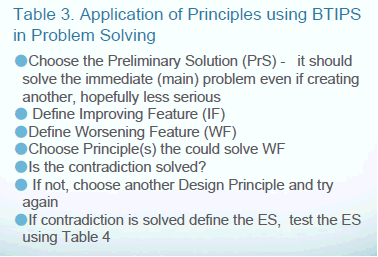
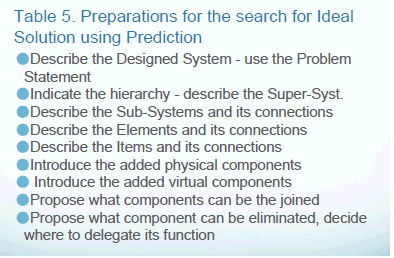
The Author writes in the conclusion:
There are still no ideal method for satisfactory solution of problem solving in Engineering Conceptual Design. There is a need for a system on which teaching could be based. ... All engineering students should take problem solving courses during the freshman year. Problem solving is an important subject to which the candidates for engineering studies should be introduced already in high schools. ...
E2. Aspects of teaching TRIZ
Christoph Dobrusskin (Philips Innovation Services, The Netherlands) ![]()
The Author introduces himself as:
Innovation Consultant at Philips in Eindhoven. Experience in the fields of: design, ideation, research, engineering problem solving, patent related work and technology planning. Regularly training engineers at Philips and in other companies on using TRIZ. Since 2014 involved with teaching creativity and TRIZ to secondary school teachers and students.
Here is the Abstract written by the Author:
Teaching TRIZ in an industrial environment commonly poses an interesting dilemma. On one hand the time to explain the concepts and ideas of TRIZ is limited, while on the other hand the amount of topics to be taught is large and, to really understand and be able to apply TRIZ, a lot of time should be spend in exercising the TRIZ tools and concepts.
The same dilemma exists, generally in an even exaggerated form, when teaching TRIZ to students and teachers in secondary schools. Based on experiences in teaching at schools, the present paper discusses avenues of overcoming some of the basic limitations that are encountered when teaching within a tight time frame and the relevance of these to teaching in Industry.
In the present paper the Author talks mostly on teaching TRIZ to students (and their teachers) of secondary schools (i.e., pre-college, middle and high schools). He explains the background and his experiences of the projects with Jet-Net (see slide right).
The big problems they encountered are shown in the two slides (below). Lack of time (in comparison to the contents desirable to teach). Lack of engagement (because of not being involved in any particular job yet). Limited attention span / complexity (for school students).
I hope you understand the slide of humorous symbols (below right).

The Author is an excellent teacher. In his presentations at ETRIA TFC every year, he gives demonstrations, experiments, and short workshops. This year he demonstrated his way of introducing TRIZ to students. It is a pity for me not to be able to reproduce his vivid presentation; but anyway, it proceeded roughly in the following steps:
- At the beginning, teacher asks the class to do a simple job saying "I am your customer, could you draw for me on a piece of paper ... (any simple task will do)". Naturally the students do the simple task well. Then the teacher say: "You all failed. Because no-one asked any question, so no-one knows what the customer - the teacher - really wanted."
- To demonstrate the inventive power of TRIZ, exercises are done with selected Inventive Principles. (Seven principles are selected: they are #1 Segmentation, #2 Taking out, #3 Local quality, #4 Asymmetry, #7 Nesting, #13 The other way round, #17 Another dimension, #25 Self service.) Examples of applying the Principles are shown, and the students are asked to think of some more examples. Visualizing the examples is useful for familiarization.
- To apply the Inventive principles for improving some simple familiar things, like shoes, chairs, etc.
The slide (right) is his summary of such a short demonstration.
The Author shows his findings in the following slides (below)
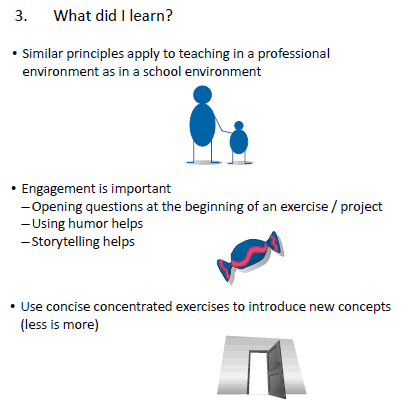
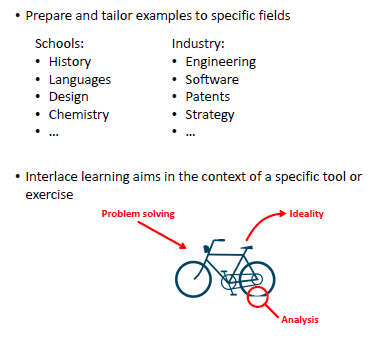
The last slide (right) shows a picture of one of his classes:
*** As you see the Author's slides (and also his paper) are simple and compact. Much more was in his talks and demonstrations. You would learn much better at the presentations and conversations with him directly, in coming chances.
E3. Product development using heuristic-systematic approach: a case study
Bartosz Pryda, Marek Mysior (Wroclaw Univ. of Sci. and Tech., Poland)
This paper is a case study conducted in a design class with 10 people. The topic chosen was to think of some innovative design of a garden table. The Author's Abstract is cited here:
One of approaches used in TRIZ to produce inventions is the systematic approach. Another one is the heuristic set of methods that facilitates concept development. Finding the root problem, followed by deep analysis and specific formulation of the inventive problem that is being solved using heuristic way of thinking can lead to a solution that meets the initially stated objective and requirements in the best way. At the end of such design process, a new invention may come up. As a result of heuristic-systematic design using TRIZ and Synectics, two products that comprise new features currently unavailable on the market were developed.
This article presents the heuristic-systematic innovation process using TRIZ and Synectics as well as concept development on an example of two inventions. The market analysis, patent mining and specific problem formulation was conducted and is presented in the article. The presented case study shows also heuristic-based concept evolution along with knowledge acquisition and deeper formulation of the problem as a response to initially stated inventive problem and market needs.
The class was to make an exercise of creative design with an emphasis of understanding the market demands. The slide (right) shows the methods used in this case study. Design Thinking, TRIZ, and Synectics were used together in sequence.
First, the people in the class were asked "How do yo use your garden tables? When do you do it? What do you do with it? Which features are important for you?" The answers are collected in the form of Empathy Map of Design Thinking, as shown in the Table (right). The contexts are categorized with Technology, Economy, Environment, and Society (TEES).
An initial image of the Garden Table is a light-weight wooden table with a rectangular top plate having a hole in the center for holding an umbrella in the case of rain.
Since such an image is conventional, the class went ahead to analyze the problem with TRIZ, especially with Functional Analysis (see the figure (right))..
It is noticeable that this is not an ordinary FA diagram for analyzing the functional relationships of components of the Garden Table but an FA diagram of the Garden Table in the super-system to understand its usage and requirements by people (or the market).
Using the FA diagram, the class discussed what are the most important functions of an novel Garden Table for responding the market demands.
Thus 4 functions are chosen as shown in the slide (right).
And the concept of the new Garden Table to be developed is formulated as shown in the slide (right).
Then ideas are generated to develop such a novel Garden Table. In this process, Synectics was used. The slide (right) is quoted from a paper by S. Koziolek et al. (2011) for explaining Analogical thinking in Synectics.
Two solutions thus developed are shown in the slides (below).
The first solution (below left) makes it possible to store food in the stowable container in the middle of the table and provides stability and ease of transport by means of water ballast.
The second solution (below right) is more focused on fun, using and serving functions. Providing the area for food serving, it is very easy and practical to serve dishes that can be easily transferred to each part of the table by means of small boats, like in Sushi restaurants. In the middle part there are gas nozzles and a grill that allows to cook dishes.
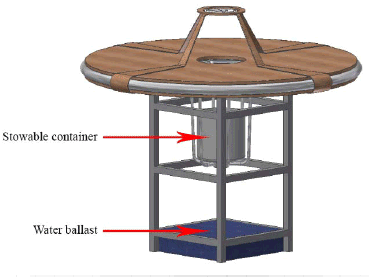
E4. Development of creative education materials for students at middle and high school using design thinking process with simplified TRIZ
Kyeongwon LEE (Korea Polytechnic Univ., South Korea) ![]()
The Author's Abstract is cited here first:
This paper explains one development of education materials with TRIZ for students at middle and high schools. They use the design thinking process with simplified TRIZ. Many teachers have complained that the conventional TRIZ is very difficult to students with too much knowledge and unfamiliar words focusing mostly on mechanical inventions. In addition they want to teach the collaborative creativity and problem finding with careful observation and curiosity considering the learning knowledge of students increase year by year.
Author thinks that the Design thinking process having strong points in problem finding with collaborative team play and simplified TRIZ” with interesting education samples are suitable to improve the creativity of students at middle and high school better through the twenty years’ experience of TRIZ propagation in Korea.
The Author reports that in South Korea TRIZ has been accepted much for these 10 years or so in big companies and is now at the maturity and declining stage in big companies but at the (early) growth stage of propagation into middle and small companies and secondary schools. For introducing TRIZ to people in such smaller companies and to young students at middle and high schools, the Author finds it important to adapt the contents and teaching style to the target people, as he writes in the Abstract. For such a purpose the Author proposes to use the framework of Design Thinking and enhance its ideation stage with (a much simplified form of) TRIZ.
In the slide (right), the Author explains his view of Design Thinking. He finds the attractive nature of Design Thinking in Team collaboration, Visual communication, and Human-centered approach. Such features are good for attracting ordinary people and young students to join the workshops of learning/exercising the method with fun.
Design Thinking (DT) has 5 steps (shown in a cyclic manner): Empathize, Define, Ideate, Prototype, and Test. The Empathize and Define steps are for finding right problem, with value to customers and inspiring to innovators. At the Ideate step, DT mostly uses brainstorming only. Hence the step can be enhanced much with (simplified) TRIZ. DT has further steps of Prototype and Test, where TRIZ does not have effective methods.
Next slide (right) shows the position of TRIZ in the Design Stages, which are composed of conceptual design stage and detailed design stage. The stages are further divided into 4 stages as shown in the middle. The first stage is Strategy, to find 'What to do'. The 2nd is 'Concept development' for deciding 'How to do it conceptually'. This stage is conventionally carried out with people's experience and intuition, and can be improved much by the introduction of TRIZ. The 3rd and 4th stages are 'Robustness & Optimization' and 'Selection and Transfer', respectively. In these stages, CAD/CAM/CAE are fully used together with methods on quality. In these latter stages, TRIZ does not have effective methods.
Shortage of TRIZ is summarized at the bottom right of the slide. No Human-centered problem finding (in the 1st stage) and Few conformation of conceptual ideas (in the 3rd and 4th stages).
In the slide (right), the Author summarizes his views:
TRIZ is weak in human-centered problem finding,
while Empathize and Define stages of DT are effective. ==> So, we should use them as Pre-TRIZ.TRIZ is weak in implementation of conceptual ideas,
while Rapid Prototype stage of DT is effective.
==> So, we should use it as Post-TRIZ.Design Thinking is weak in generating innovative ideas,
while TRIZ is effective.
==> So, we should use TRIZ in the Ideate stage of DT.Namely, use we should DT and TRIZ together for mutual compensation.
On the basis of methodological understanding as described above, the Author has been working since 2014 to promote TRIZ/DT to secondary school students. He shows his framework first in a slide and then demonstrates its contents by using a case study.
The slide (right) shows the Author's framework of teaching creative problem solving methods at middle and high schools. It has 3 Levels (Basic, Intermediate, and Advanced) corresponding to the age of students, taking the growth of them into account. Workshop-style teaching is used with the methods of Design Thinking + Simplified TRIZ. Problems to be handled are adapted to the interest of students. Methodical framework is Design Thinking for all the levels (implicit in the slide). At the Ideate stage of DT, for generating creative ideas, original brainstorming method is gradually enhanced and replaced with simple TRIZ. Namely, BS but no TRIZ at the Basic Level, BS + Simple TRIZ at the Intermediate Level, and BS + Simple TRIZ + More TRIZ at the Advanced Level. The contents of Simple TRIZ and More TRIZ in this table will be explained later.
The Author demonstrates a case study at the Advanced Level conducted at a workshop for high school students. The problem is to improve the 'Self-camera Stick of Smart phone', which is very popular in Korea since 2014. The slide (below left) shows a worksheet at the Empathize stage. Students are requested to use Self-camera sticks and to observe others using them and to gather complaints and improving points. Next slide (below right) shows 5 complaints (or problems) which were derived through discussion at the Define stage. For each of the complaints, ideas are generated by experience, intuition, and brainstorming (i.e. Ideate stage at the Basic Level). For the Complaints #1, #2, and #3, some intuitive ideas are written. But for Complaint #4 'Protruding holder of stick in pocket' no idea is obtained. For Complaint #5 'Short length of the stick for wide shooting', a simple idea is to make the stick long. The idea, however, has the demerit that a long stick is hard to carry around and apt to deflect. Thus we encounter a contradiction here.
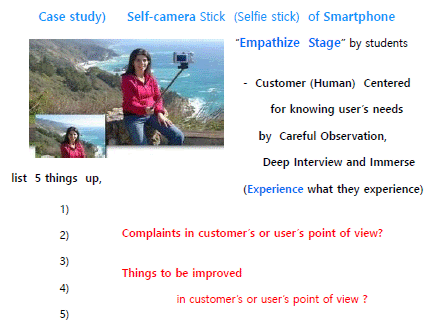
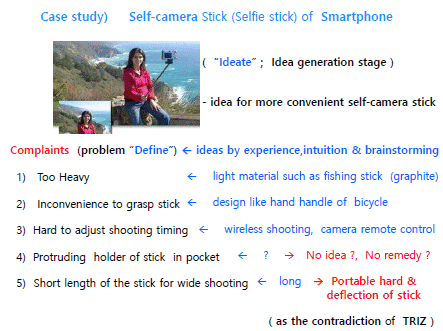
Then the Author explains in the next two slides (below) how to handle contradictions in TRIZ (specifically in "Quick TRIZ" which the Author developed in 2012). Let us build up the contradiction clearly in a diagram. First in Box B, we write the purpose we want to achieve. In this example, we want 'to shoot wide'. Then we should think of some means to achieve the goal without worrying about its difficulty. In the Box D, we write the Means: 'Length of the stick has to be long'. Then we find its difficulty, or a secondary problem, 'Heavy more', and write it in Box C initially in the negative form '-C: Heavy more', and then rewrite it in the positive form to solve the problem:'+C: not Heavy more'. Then our task is to achieve the two tasks B and +C together. We write the task (or Common goal) in Box A. A simple means to achieve +C alone is the reverse of the means D. We write the reverse means in Box D' anyway: D' (= -D): Length of stick is NOT long. In this manner we have built up a diagram with a preset framework (A, B,C, D, and D'), where D and D' are always simple reverse of means and under conflict (or contradiction) with each other. This is the 'Quick-TRIZ way' of deriving the Physical Contradiction in TRIZ, which is understood as 'the Conflict between Means' in Quick TRIZ. The derivation is simple under the guideline of the framework with 5 Boxes, and the intention of such a derivation need to be explained now to the students. The conflict between the reversal means may look impossible to solve, but, as a mater of fact, can be solved often smoothly by use of 'Separation Principles' developed in TRIZ.
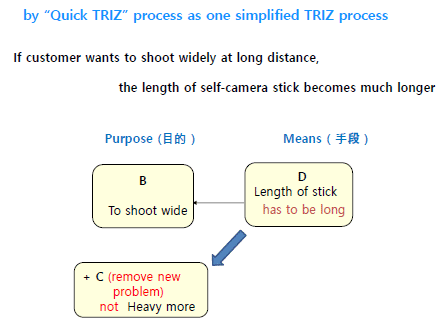
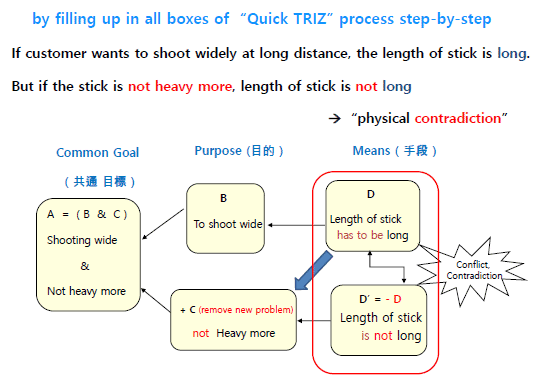
Then the students are guided to apply Separation Principles of TRIZ (see slide (right)). Separation in time, Separation in space (including Separation in whole and parts), and Separation on conditions are explained to the students in familiar words (without mentioning Inventive Principles). In this case study, the students answered 'a larger antenna stick when shooting wide, and an ordinary stick in ordinary chances'. Another solution method is to use other cheap resources. Students thought of solutions of 'Wide-angle lenses' and 'digital zooming'.
As described so far, at the Intermediate Level for the 3rd year middle school students, the methods of clarifying the contradictions and of solving them with separation principles and with resources are taught with exercises. Such methods are much simplified in Quick TRIZ in comparison to the conventional TRIZ.
The Author discusses on his "Quick TRIZ" approach in the slide (right). "Quick TRIZ" uses the 5-box diagram for revealing the contradictions in the problem and applies separation principles for solving the contradictions. The 5-box diagram, originally developed in TOC (Theory of Constraints) and adapted by Darrell Mann and by the Author, Kyeongwon Lee, represents both Technical Contradiction (between Box B and Box C) and Physical Contradiction (Between Box D and Box D'). The Author uses the diagram for deriving the latter directly.
The Author proposes the terms 'Conflict between Purposes' (in place of Technical Contradiction) and 'Conflict between Methods' (in place of Physical Contradiction). And he suggests to introduce Principles in TRIZ slowly step by step. ("Invention Song" is a charming song developed by Jonho Shin with the verse of 8 Invention Principles.)
In this manner the "Quick TRIZ" process is well fit to secondary school students as well as many other adult TRIZ beginners.
At the Advanced Level of Creativity education for high school students, the Author proposes to introduce the 9-Window Method of TRIZ at the Ideation Stage (of DT). In the students workshops, the concept of the 9-Window Method is explained with some examples, and then it is applied to the present problem with the guidance by the Instructor. The slide (below) demonstrates the results. The numbers 1 to 8 in small rectangles shows the sequence of filling in the 9 Windows. At the center (#1), the current system is set as 'Self-Camera stick with remote control of Smart phone'. Then its subsystems (#2) and super system (#3) are considered. Then at Window #4, the Past System (about 2-3 years ago) is written as 'Self-Camera stick of Smart phone with mechanical control'. After considering the Windows #5 and #6, we go ahead to think of the system in the near future (in about 2 years). Sub-systems and Super-systems in near future may be estimated on the basis of trends in recent years. Using these observations and predictions, we would like to forecast the next generation of Self-camera system.
The slide (right) show the results obtained by the high school students. 5 new ideas were obtained for the next-generation Self-camera stick, after 6 hours of workshop.
Idea #1 is a wide-angle lens or digital zooming. (This is already mentioned in the previous slide.) Idea #2 is a Self-camera stick having the capacity of electric power generation by use of mechanical motion by hand. Idea #3 is a Self-camera stick with an auxiliary function as a stick for mountain climbing. Idea #4 is a Self-camera stick with the function as a stick for self-protection for young women. Idea #5 uses a small cheap drone in place of a stick to take self-photoes.
(Note that among these 5 ideas, Idea #1 and Idea #5 seem to address to the contradiction of 'Long AND Not Long'. Other 3 ideas (Ideas #2, #3, and #4) introduce some additional functions, without directly solving the Contradiction of the current focus. In the workshop of this case study, the 8 selected TRIZ Inventive Principle seem not explained and used.)
The slide (right) shows the conclusions of the present paper. Conventional materials for TRIZ education are not suitable for young students at secondary schools. Hence new materials have been developed by the Author and colleagues under the support of Korean Government. Design Thinking was introduced as the overall process and its Ideate stage was enhanced by simplified TRIZ tools (i.e., 'Quick TRIZ'). The Author put much stress on the aspects of "Fun, Curiosity, Action learning, Collaboration, Visual communication, and Problem finding with Empathize" in addition to logical thinking with TRIZ.
*** This is an excellent paper for promoting the education of creative thinking and creative problem solving for young students at secondary schools (ages from 14 to 19 years). It is also illustrative for promoting such education/training for ordinary adult people.
E5. Idea Generation with Substance-Field Analysis: the Influence of Prior Knowledge and Practical Experience
Iouri Belski (RMIT, Australia), Anne Skiadopoulos (Swinburne Univ. of Tech., Australia), Guillermo Aranda-Mena (RMIT, Australia), Gaetano Cascini (Politechnico Milano, Italy), Davide Russo (Univ. of Bergamo, Italy) ![]()
*** This is a nice paper; but I would suggest its title should better be: "Importance of General Knowledge in Creative Idea Generation: An Experiment and Discussions".
The Abstract written by the Authors is as follows:
Recent studies reported on the positive influence of Systematized Substance-Field Analysis (Su-Field) on students’ ability to generate ideas for a knowledge-rich open-ended engineering problem. It was discovered that the first year students from universities in Australia, Czech Republic, Finland and Russia who were simply exposed to the names of the eight fields of MATCEMIB (Mechanical, Acoustic, Thermal, Chemical, Electric, Magnetic, Intermolecular, Biological) during idea generation produced at least two times more ideas when the students from control groups that were not exposed to any prompts. Also, students that were shown the names of the eight fields of MATCEMIB proposed solution ideas that covered significantly broader range of engineering principles of operation.
This paper presents the results of an experiment that engaged 64 students enrolled in the Master degree programs at two universities in Italy. Comparison of performance of undergraduate students with that of postgraduate revealed that although general knowledge seems to be more important for creative performance than discipline knowledge, in order to utilise his/her general knowledge fully a person requires skills in ideation techniques that help searching his/her knowledge repository effectively. Moreover, it has been found that a ‘manual’ search of a person’s knowledge repository with help of MATCEMIB expanded the number and breadth of solution ideas more than additional knowledge and years of practical experience.
The present paper is based on a series of experimental works conducted internationally by the top Author, Iouri Belski (Royal Melbourne Institute of Technology, Australia), and reports the results of a new experiment carried out in Italy by the last two coauthors.
The present study has two main motivations as shown in the 2 slides (below). The 1st motivation is the realization that current technologies are extending rapidly by the introduction of various knowledge in the fields different from the conventional one. The slide (below left) shows such an example, in the case of cleaning methods of silicon wafers. The 2nd motivation is shown in the slide (below right). It is a desire to obtain reliable, experimental proofs what methods/tools for systematic innovation work (and not work).
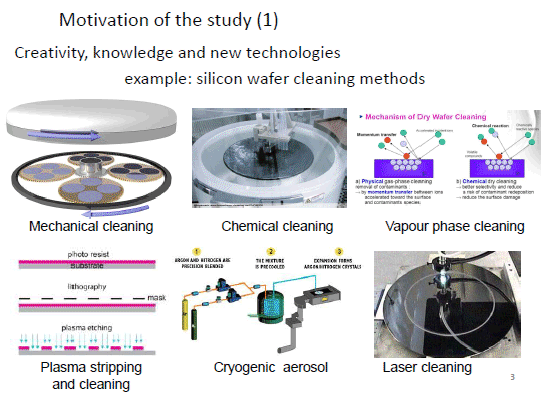

It has been widely accepted, according to T.M. Ababile (1983) for example, that creativity (or creative performance) of a person are supported by three components, namely, Domain-relevant skills, creativity relevant skills, and task motivation, as shown in the slide (right). However, recent developments in technology seems to suggests the needs of the 4th component, i.e., General Knowledge. A previous survey work by Belski et al. revealed that many engineering experts regarded the General Knowledge has become more essential than the factors like Discipline knowledge, Years of practice, and Creativity techniques.
Thus the present series of study has been trying to prove the efficacy of General Knowledge by experiments.
The experiment was designed and conducted originally in Australia for undergraduate first year students, and then carried out in the same way in Czech Republic, Finland, and Russian Federation.
The experiment was carried out this time in Italy, for 64 Master students (i.e., 7th or 8th semester students) from two universities. Experiments were done separately at the two universities in a common manner, and since the results are very similar they are combined as one experiment in this report.
The process of the experiment and the way of evaluating the results are explained here, on the basis of the paper and the presentation slides. Though the slides are written in English, the experiments in Italian universities were all done in Italian translation.
The students are assigned randomly to 4 separate groups; let's say Groups (0), (1), (2), and (3). The experiment of each group was done independently from other groups using the same problem and same process except slight difference in showing different (or no) keywords.
The Problem used is shown in the slide (right). This slide was shown to the group for 2 minutes. (No further explanation nor Q&A on the problem. Standard worksheets for writing the ideas were handed already to the students.
Then the 4 different kinds of slides, as shown (right), are displayed to the 4 groups: for Group (0) (or Control group) no keywords, for Group (1) a keyword selected randomly, for Group (2) a name of field, and for Group (3) a name of field together with several sub-fields. Such a slide is displayed to the respective group for 2 minutes. For Groups (1)(2)(3), the main keyword is announced by the Instructor without any other comments (no announcement of the sub-fields for Group (3)). For each group, 8 slides of the same type are displayed one after another for 2 minutes each. The students are advised to write down as many ideas without any restriction to the relevance of the keywords.
The series of 8 keywords for each group are explained below.
For Group (0), no keywords are displayed. So the students try to think of as many ideas as possible in their own ways. For Group (1), 8 keywords generated randomly using a dictionary are displayed. They are shown in the slide (below left). For Group (2), 8 names of the Fields, known as MATCEMIB in TRIZ, are displayed. They are listed in the left column of the slide (below right). Note that 'Fields' here do not mean the fields of academic disciplines (like physics, chemistry, biology, etc.) but the principal types of interactions for describing the nature in terms of 'Substances and Fields', in the sense that any thing belongs to Substances while any interaction between Substances belongs to Fields. TRIZ recognizes 8 main types of Fields, i.e., Mechanical, Acoustic, Thermal, Chemical, Electric, Magnetic, Intermolecular, and Biological, and calls them MATCEMIB as an acronym. For Group (3), the 8 main Fields together with their typical interactions are displayed, as listed in the slide (below right). As you see, the slide (below right) is a very compact summary of all the interactions to describe the nature.
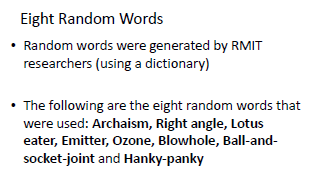
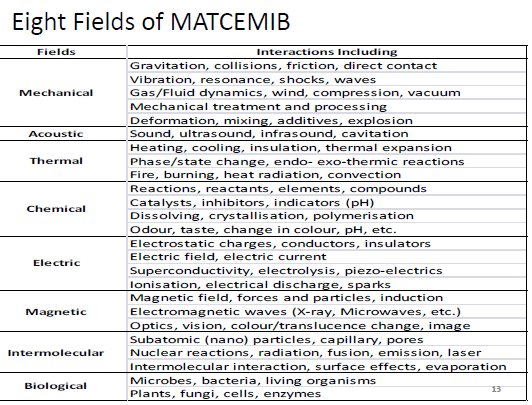
Thus the experiment for each group of students finishes in 18 minutes. The ideas written by every student are processed for evaluation/reporting in the following way.
The slide (right) shows the method of reporting the results of the experiment. At each university, 2 independent assessors evaluated the students' results using the same criteria, and the consistency between the 2 assessors is confirmed statistically. For each individual student, distinct ideas proposed are counted in number, and are assigned individually to the most relevant field of MATCEMIB.
Since the results at the 2 Italian universities are similar, they are combined for each group. Then the numbers of distinct ideas generated by individual students are averaged for each of the 4 groups. And (average) Breadth of generated ideas for each group is obtained by the following equation:
Breadth = sum of (percentage of students who generated at least one idea in the Field) for the 8 Fields.
The results of the experiment in the Italian universities are summarized in the slide (right). Note that the slide writes 'Post graduates' but actually the 4th grade students of the university at the Masters Course, where students typically obtain the Masters degree after 5 years of study.
The table shows, for the Groups (0)(1)(2)(3), the number of students, the average number of distinct ideas generated by individual students, and the average Breadth of ideas generated by individual students in terms of the 8 Fields of MATCEMIB.
The results are statistically evaluated as shown at the bottom of the slide (right). Number of ideas for Groups (1)(2)(3) is significantly larger than that for Group(0). Breadth of ideas for Groups (2)(3) is significantly above those for Groups (0)(1).
The results of the present experiment are compared with those previously carried out at 4 different countries for the 1st year undergraduate students (see slide (right)).
The observations on the average number and average Breadth of generated ideas for the four Groups at each university are essentially same as mentioned in the slide.
Comparison of the present results in Italy with those in 4 other countries is mentioned at the bottom of the slide (right). Results in Italy are statistically significantly above those in Australia but are not significantly different from those in other 3 countries.
The slide (right) shows the conclusion of the present study written by the Authors.
The focus of the present study is to examine whether General Knowledge (GK) is essential as the 4th component of Creative performance. The Authors are very moderate in showing the conclusion on this matter with the ? mark.
Concerning to the General Knowledge, the Authors refer to the Creativity-relevant skills, especially knowledge of heuristics for generating novel ideas.
(This conclusion slide is mainly written by the top Author, Iouri Belski, I suppose.)
The last slide of the presentation is shown (right). It is written by the presenter, Gaetano Cascini, as his 'Personal reflections'.
The 1st and 2nd points of discussions raised here are very interesting. We may think of various types of problems for similar experiments, and may try experiments with different types (and areas) of problem tasks for the same people.
The 3rd point is also worthy of consideration. In the present study one experiment is only 18 minutes long. If 30 minutes or 60 minutes are given for each person for solving a problem, the capability of the person and and the effect of the supporting key words will become more remarkable.
*** This is a very interesting paper, and we can extend this experiment in a much more practically meaningful manner, I think.
In the present series of study, the experiments are carried out with university students. But it should be more interesting and important to carry out similar experiments with various engineers and scientists. How about young fresh engineers vs. old professional engineers? How about mechanical/electric engineers, physicists, chemists, etc?
For me it is apparent that the information given to the groups is useful in the order: Group (0) < Group (1) < Group (2) < Group (3). Thus comparing the values of such information is less important. For practical usefulness, we should use the information given to Group (3), i.e., 8 Fields with typical interactions, as shown in the MATCEMIB slide. A print of the table should be handed to the people from the beginning. The table is a compact and yet comprehensive summary of 'General Knowledge' (and not a summary of 'Heuristics for idea generation', like a list of 40 Inventive Principles in TRIZ). People can think of various examples of natural phenomena and artificial devices of each interaction, depending on their own background knowledge, both domain specific and general.
One minor point to be considered: We need some suitable name of representing the 'General Knowledge' in such a compact form of 'Fields' (as shown in the slide 'MATCEMIB'). The Authors use the term 'Substance-Field Analysis' in the title of this paper. But I think it not suitable because 'Substance-Field Analysis' or 'Substance-Field Modeling' is the word in TRIZ to analyze cases of functional interactions in a particular triangular representation, in place of more widely used 'Functional Analysis'. 'Fields' here is the term originated by Altshuller for expressing the general concept of all kinds of interactions. It is meaningful when we understand the whole world in the pair of 'Substances' and 'Fields'. But when people hear 'Fields' in the context of 'General Knowledge', they naturally think of 'Fields of study', 'Academic disciplines', 'Areas of issues', etc. but not 'Types of interactions'. MATCEMIB is a good acronym for remembering the 8 main types of interactions (or 'Fields'). But it will stay as a jargon in TRIZ. We should note that the concepts (but not the terms) of 'Fields' and its 8 main types MATCEMIB are acceptable for all the people in the scientific world as a basic concept of 'General Knowledge'. The slide originally made in TRIZ in the name of Table of MATCEMIB is general enough for the whole world of science. We need to have a general name for expressing such a compact representation of 'General Knowledge' of the whole nature and whole artifacts. ...
By accumulating the results of these experiments with several type of problems, with different kinds of people, in different organizations and countries, we will certainly be able to prove the essential importance of General Knowledge in creative problem solving. This will certainly give influence on education policies at various levels (from primary schools, to universities, and to professional institutions).
Similar tasks may also be used for evaluating personal capabilities. And hence may be used for evaluating the effects of education/training and for screening job candidates, etc.
Last updated on Jul. 18, 2017. Access point: Editor: nakagawa@ogu.ac.jp